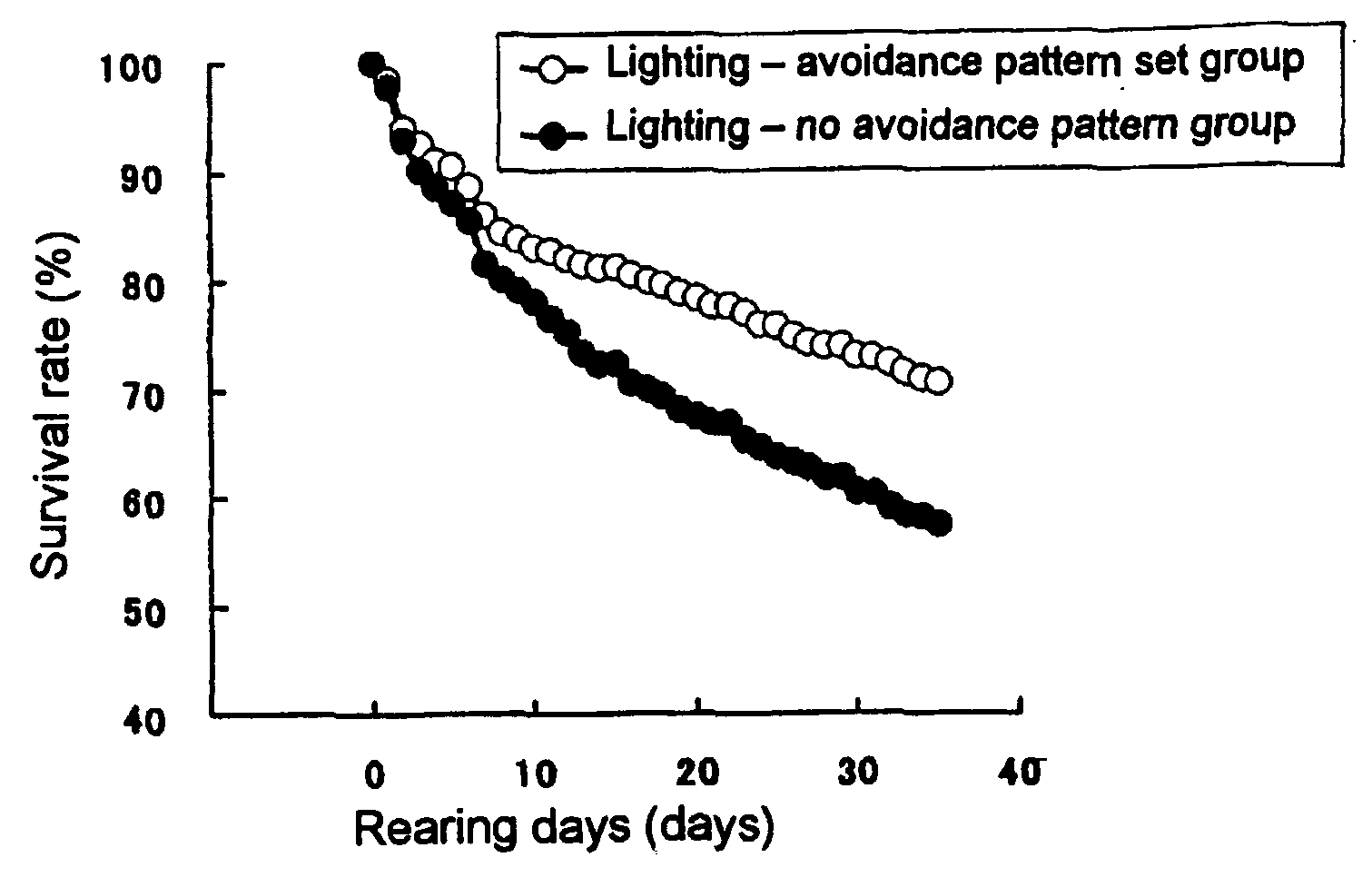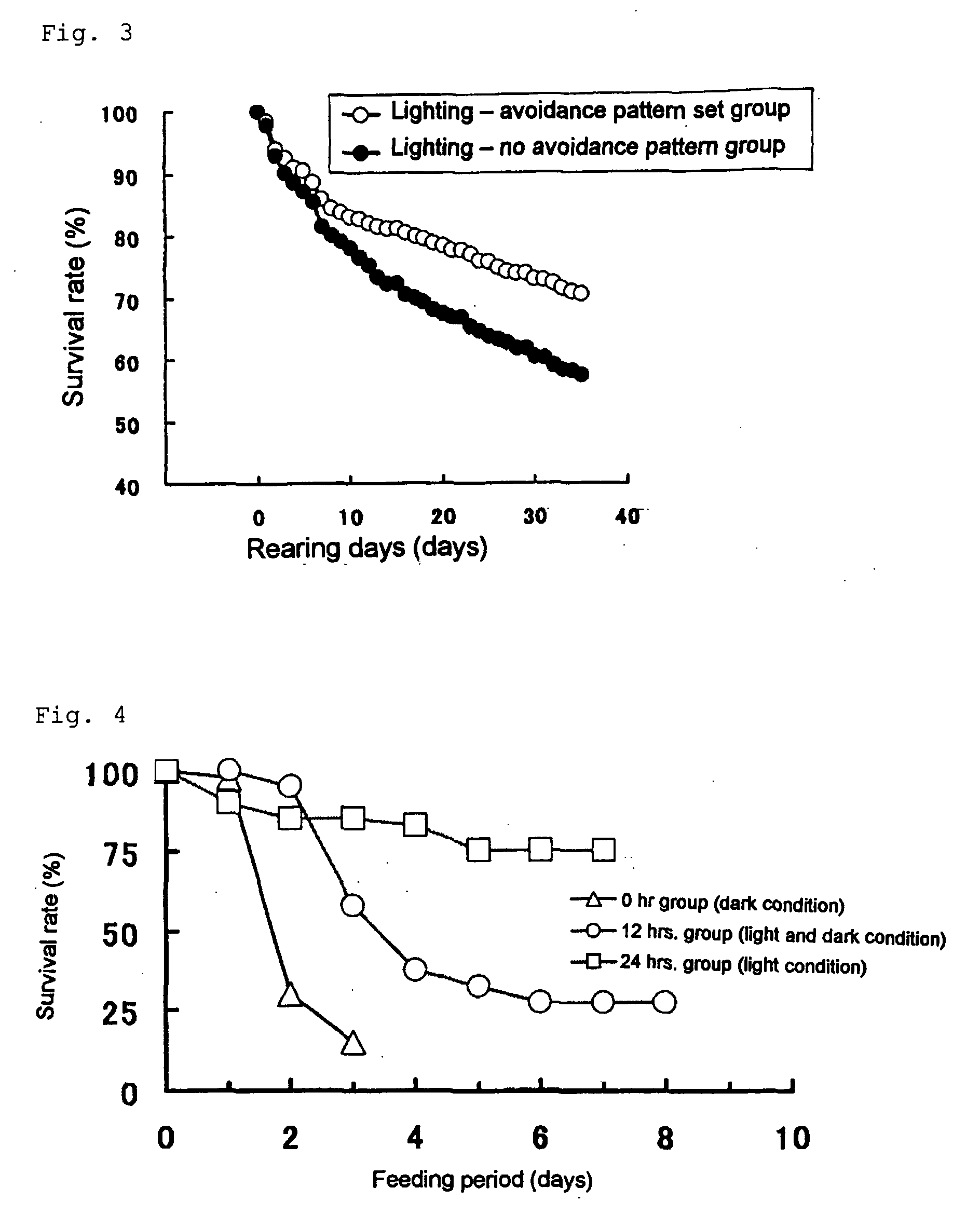Method for Preventing Abnormal Behavior of Tuna
a technology for abnormal behavior and tuna, applied in pisciculture, climate change adaptation, applications, etc., can solve the problems of large number of tuna killed in juvenile and young adult fish stages, high mortality, collision death, etc., and achieve the effect of preventing fright behavior and collision death of tuna, high mortality, and increased reflected ligh
- Summary
- Abstract
- Description
- Claims
- Application Information
AI Technical Summary
Benefits of technology
Problems solved by technology
Method used
Image
Examples
example 1
[0057]Stress reaction of bluefin tuna to light and color of water tank wall and bottom surfaces-1
[0058]In order to reveal a cause of-cannibalism, fright behavior and collision death, juvenile tuna were placed in various water tanks with different combinations of illumination and colors, respectively, and examined fright behavior rates, survival rates, cortisol levels as the hormone showing a stress state of fish, and the like to study the influence of illumination, the color of a water tank, brightness, reflected light, and the like.
[0059]Method
[0060]Three test groups were provided. Each group included three set of nine 30 L-transparent polycarbonate water tanks, each of which was equipped with doubled transparent, white or black polystyrene bags set on the wall and bottom surfaces thereof. For each tank, lighting was conducted at the illumination of water surface area of 25, 250 or 2,500 lx with white fluorescent light sources. Juvenile bluefin tuna of 40 days after hatching were p...
example 2
[0067]Stress reaction of bluefin tuna to light and color of water tank wall and bottom surfaces-2
[0068]In order to reveal a cause of cannibalism, fright behavior and collision death, juvenile tuna were placed in various water tanks with different combinations of illumination and colors, respectively, and examined fright behavior rates, survival rates, cortisol levels as the hormone showing a stress state of fish, and the like to study the influence of illumination, the color of a water tank, brightness, reflected light, and the like.
[0069]Method
[0070]Five test groups were provided. Each group included three sets of a 10 L-plastic transparent water tank as a control group, the same water tank equipped with a black vinyl sheet set on the inside or the outside wall and bottom surfaces thereof, the same water tank equipped with a black vinyl sheet set on the inside wall and bottom surfaces and further equipped with a transparent vinyl sheet set thereon, and the same water tank equipped ...
example 3
[0074]Stress reaction of bluefin tuna to light and color of water tank wall and bottom surfaces-3
[0075]In order to develop a method for preventing the occurrence of abnormal behavior such as fright behavior and the collision death, buffering equipment for alleviating visual stimuli was used for examining its effect.
[0076]Method
[0077]Two groups were provided. Each group included three sets of six 1.6 t-water tanks each of which equipped with a transparent vinyl sheet set on the inside wall and bottom surfaces of the tank. In three tanks out of these 6 water tanks, as a test group, sea water was poured-into only the inside the transparent vinyl sheets of the tanks, and transparent buffering materials having air encapsulated portions were placed between the vinyl sheets and the wall and bottom surfaces of the tanks. In the remaining three tanks, as a control group, sea water was poured into the inside the transparent vinyl sheets as well as between the sheets and the wall and bottom su...
PUM
 Login to View More
Login to View More Abstract
Description
Claims
Application Information
 Login to View More
Login to View More - R&D
- Intellectual Property
- Life Sciences
- Materials
- Tech Scout
- Unparalleled Data Quality
- Higher Quality Content
- 60% Fewer Hallucinations
Browse by: Latest US Patents, China's latest patents, Technical Efficacy Thesaurus, Application Domain, Technology Topic, Popular Technical Reports.
© 2025 PatSnap. All rights reserved.Legal|Privacy policy|Modern Slavery Act Transparency Statement|Sitemap|About US| Contact US: help@patsnap.com



